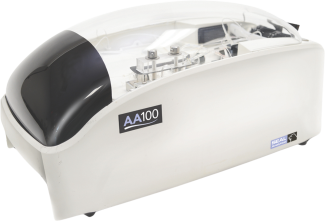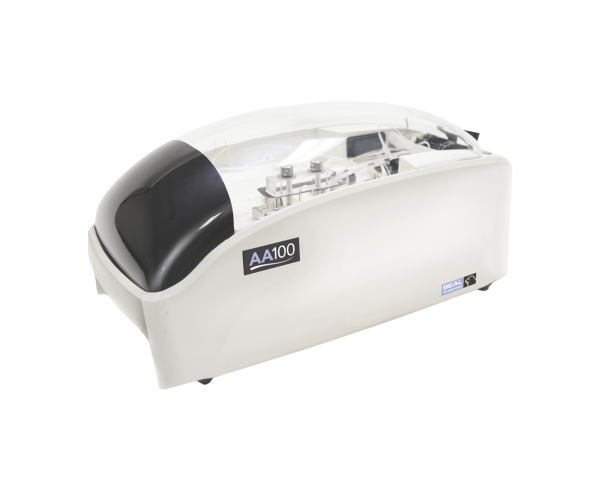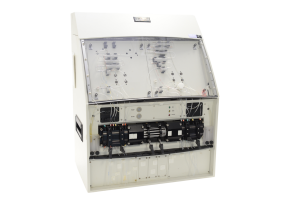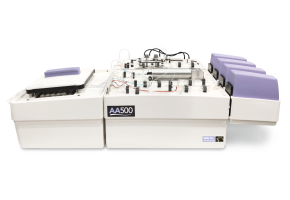AA100 AutoAnalyzer
Our lowest footprint segmented flow analyzer, offering inline sample preparation and automated, low-level colorimetric analysis for up to two methods.

Compact, Automated Two-Channel Analysis
The compact dual channel AA100 auto analyzer is the ideal chemistry analyzer for laboratories running only 1 or 2 dedicated chemistries. Like the bigger AA500 AutoAnalyzer it is designed specifically for environmental and industrial testing laboratories. Using Segmented Flow Analysis techniques (a version of Continuous Flow Analysis) the AA100 AutoAnalyzer fully automates repetitive and complex sample analysis steps, including sample distillation. With its very small footprint, this compact auto analyzer will fit into any bench top, in any orientation. Despite its compact size and simplicity of use, the AA100 Auto Analyzer delivers you some of the same features as the bigger AA500 and QuAAtro39 AutoAnalyzers including the low detection limits, exceptional reproducibility, glass coils, digital photometer, LED light source, and a very low cost per test.
.jpg?resolution=1200x650&quality=95)
AA100 AutoAnalyzer Brochure
View the full specificationsWhy select the AA100?
Automation
- Automated colorimetric analysis of a wide range of nutrients and analytes
- Ammonia analysis by in-line gas diffusion eliminates need for distillation as well as pH and salinity issues.
- Integrated distillation manifolds for cyanide, phenol, and ammonia, as well as inline digestion for ISO-Cyanide
- SEAL Sampler series designed and manufactured by SEAL Analytical for improved segmented flow analysis sampling
Compliance
- Segmented reaction stream allows for a complete reaction between reagents and sample for maximum sensitivity
- LIMS-compatible software available in standard and GLP versions
- 24-bit high resolution detectors provide ultra-low detection limits and wide dynamic ranges
- High-precision detection with bubble-through technology and LED light sources
Efficiency
- Ability to add samples during the run
- Small footprint ideal for limited bench space
- Easy operation and intuitive software
- Low-cost analysis
Support
- Visual manuals and descriptive checklists
- Immediate support available from SEAL chemists via email, phone, screenshare, or video call
- In-depth training during installation
- Guides and webinars available for continued learning
Highlights of the AA100


.jpg?resolution=595x500&quality=95)

.jpg?resolution=595x500&quality=95)
With the smallest footprint in SEAL’s analyzer suite at less than 2 square feet, the AA100 accommodates small labs and low bench space while providing powerful automation options.
In addition to analysis, the AA100 can perform inline distillation, dialysis, and dilution. Eliminate distillation steps entirely for ammonia with inline gas diffusion options for further streamlined analysis.
Utilizing segmented flow analysis, SEAL flow analyzers use less reagent than other variations of continuous flow analysis. Segmented flow also brings the reaction to reach complete color formation, allowing the signal to reach a steady state for precise measurement.
The AA100 digital photometer utilizes low-maintenance LED light sources and provides high sensitivity, wide dynamic ranges, and low detection limits.
How the AA100 Works
Step 1
Startup and Baselines
The system is powered on and wash solution is pumped through the manifold. After the baseline has stabilized, reagents are introduced through the peristaltic pump and into the manifold via flow-rated pump tubes. A stable baseline is achieved before analysis begins.
Step 2
Samples are loaded and scheduled
A sample list or sequence is entered into the software, either imported directly from LIMS or a spreadsheet, or entered manually. If using a syringe diluter, auto-dilution factors are assigned. Samples are loaded onto the sampler.
Step 3
Sampling begins
Once the run is started, the standards and samples are pulled sequentially through the sample probe by the peristaltic pump and flow-rated pump tubes. The sampler returns to the wash bath between samples for cleaning. The sample can be split into two channels as it approaches the pump for simultaneous analysis of multiple analytes. As the sample enters the manifold, an air bubble is injected every 2 seconds to provide additional separation between samples.
Step 4
Reaction underway
As the samples pass through the manifold, precise volumes of reagents are injected at specific points, pulled through the peristaltic pump by their own flow-rated pump tubes. The reaction solution passes through a range of apparatuses on the manifold such as mixing coils, dialyzers, gas diffusion blocks, and more to facilitate the colorimetric reaction.
Step 5
Detection takes place
The reaction solution reaches peak color development before passing into the flowcell. Using a high-resolution LED digital photometer, constant absorbance readings of the flow are measured and plotted on a chart in the AACE software in real time. As the colored reaction solution enters and leaves the detector, peaks are formed on the chart. Peak height is then measured and compared to the calibration to calculate a concentration value of the sample.
Step 6
Post-run dilutions and shutdown
After the run completes, over-range samples can be automatically diluted using a syringe diluter and reanalyzed if desired. At the end of the run, the pump can be programmed to a slow mode to reduce reagent use after the run is complete.
.jpg?resolution=1200x650&quality=95)
Powerful AACE Software
All instrument control and data acquisition are managed through powerful and intuitive SEAL AutoAnalyzer Control and Evaluation (AACE) software. Designed in-house at SEAL Analytical, AACE is compatible with Windows 7 - 11 and offers regular updates keeping up with new operating systems. Offering LIMS import and export compatibility and GLP-compliance, AACE is compatible with all laboratories' data-handling needs.
AA100 AutoAnalyzer Methods
Explore a wide range of our most popular methods for environmental, agricultural, industrial, and other applications on the AA100 AutoAnalyzer. Don’t see what you’re looking for? Contact our team to discuss our full method options.
SEAL Analytical has more than 1,000 documented segmented flow analyzer methods, with new applications regularly being developed in our laboratories. USEPA, ASTM, ISO, AOAC, DIN, CORESTA and other international regulatory compliant methods available.
| Analyte | SEAL Method # | Lowest Range | Highest Range |
| Ammonia | E1001 | 0 - 600 μg/L as N | 0 - 14 mg/L as N |
| Cyanide | E022 | 0 - 50 µg/L as CN | 0 - 500 µg/L as CN |
| Nitrate | E1003 | 0 - 350 μg/L as N | 0 - 8 mg/L as N |
| Nitrite | E1002 | 0 - 250 µg/L as N | 0 - 2.5 mg/L as N |
| Nitrogen, total Kjeldahl | E1006 | 0 - 0.75 mg/L as N | 0 - 12 mg/L as N |
| Nitrogen, total Kjeldahl | E1006 | 0 - 0.75 mg/L as N | 0 - 12 mg/L as N |
| Phosphate | E1004 | 0 - 750 μg/L as P | 0 - 10 mg/L as P |
| Phosphorus, total Kjeldahl | E1005 | 0 - 1.0 mg/L as P | 0 - 9.0 mg/L as P |
Methods with Inline Gas Diffusion (eliminating need for manual distillation)
| Analyte | SEAL Method # | Lowest Range | Highest Range |
| Ammonia (Phenate Reagent) | E020 | 0 - 0.8 mg/L as N | 0 - 20 mg/L as N |
| Ammonia (Salicylate Reagent) | E021 | 0 – 1.2 mg/L as N | 0 – 14 mg/L as N |
| Nitrogen, total Kjeldahl | E1009 | 0.078 - 10 mg/L as N | 0.078 - 10 mg/L as N |
| Analyte | SEAL Method # | Lowest Range | Highest Range | Inline Pretreatment |
| Ammonia | E001 | 0 - 800 μg/L as N | 0 - 15 mg/L as N | |
| Ammonia | E007 | 0 - 2 mg/L as N | 0 - 13 mg/L as N | |
| Ammonia | E035 | 0 - 1000 µg/L as N | 0 - 30 mg/L as N | Dialysis |
| Cyanide, total | E017 | 10 - 100 µg/L as CN | 100 - 1000 µg/L as CN | UV Digestion, Distillation |
| Cyanide, total | E023 | 0 - 64 µg/L as CN | 0 - 1500 µg/L as CN | UV Digestion, Gas Diffusion |
| Cyanide, WAD | E018 | 0 - 100 µg/L as CN | 0 - 1000 µg/L as CN | Distillation |
| Cyanide, WAD | E023 | 0 - 64 µg/L as CN | 0 - 1500 µg/L as CN | UV Digestion, Gas Diffusion |
| Nitrate | E003 | 0 - 200 μg/L as N | 0 - 5 mg/L as N | |
| Nitrate | E008 | 0 - 6 mg/L as N | 0 - 6 mg/L as N | |
| Nitrite | E002 | 0 - 150 μg/L as N | 0 - 4 mg/L as N | |
| Nitrite | E048 | 0 - 200 µg/L as N | 0 - 3.2 mg/L as N | Dialysis |
| Nitrogen, total | E005 | 0 - 200 µg/L as N | 0 - 6 mg/L as N | |
| Phenol | E009 | 0 - 200 μg/L as Phenol | 0 - 5 mg/L as Phenol | Distillation |
| Phosphate | E004 | 0 - 800 μg/L as P | 0 - 12 mg/L as P | |
| Phosphate | E036 | 0 - 1000 µg/L as P | 0 - 40 mg/L as P | Dialysis |
| Phosphorus, total | E006 | 0 - 800 μg/L as P | 0 - 12 mg/L as P |
AA100 in Peer-Reviewed Research
See how scientists worldwide utilize the SEAL Analytical AA100 in their research - from water quality monitoring and seawater nutrient detection to soil fertility studies and more. Browse the curated publications and research articles below to see real-use cases for SEAL Analytical AutoAnalyzers.
Other models
Frequently Asked Questions
Below, we’ve listed a few frequently asked questions that will help you better understand our Continuous Flow Analyzers. If you don’t find the answer you're looking for, please don't hesitate to contact our support team for further assistance.
Our continuous flow analyzers can analyze samples at up to 120 samples/hour per channel, for a total of up to 600 tests per hour.
Our continuous flow analyzers utilize segmented flow analysis, injecting controlled bubbles at a regular interval which provides several benefits. The bubbles reduce carryover by adding physical separation between sample and wash solution, they improve the mixing of sample and reagent in-between air bubbles, they scrub the inner surface of the glass coils as the move along, and they provide a visual of the flow through the system for easy fluidic checks.
Segmented flow analysis and flow injection analysis are both types of continuous flow analysis. In segmented flow analysis, a gas bubble is injected into the sample stream at regular intervals (see question above). In flow injection analysis, samples an reagents are pumped into a manifold under pressure without any air bubble injection. Each type of continuous flow analysis uses different methods for analyzing the peaks charted as samples pass through the detector. We discuss these differences in detail here.
With minimal moving parts, segmented flow analysis has an advantage in requiring little routine maintenance. The maintenance involved includes rinsing out the channels after each run using the defined cleaning protocols for the chemistry ran on the instrument, releasing the platen so the pump tubes are not compressed when not in use, changing the flow-rated pump tubes at 200 hours of use, and keeping the pump clean and lubricated. Each SEAL analyzer comes with checklists and visual guides for these easy procedures, and our technical support team is always happy to assist with any questions.
Related articles
.jpg?resolution=428x267&quality=95)
.jpg?resolution=428x267&quality=95)
.png?resolution=428x267&quality=95)
Need support? We are here to help
Request Information
Fill out the form below to request information about our products and services.

.jpg?resolution=290x200&quality=95)
.png?resolution=290x200&quality=95)

